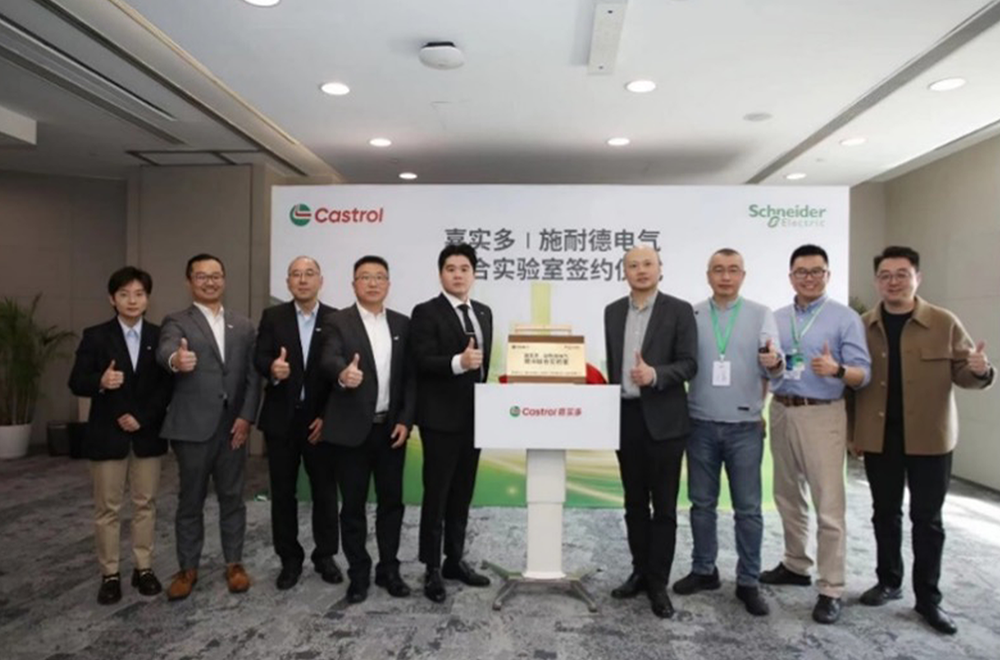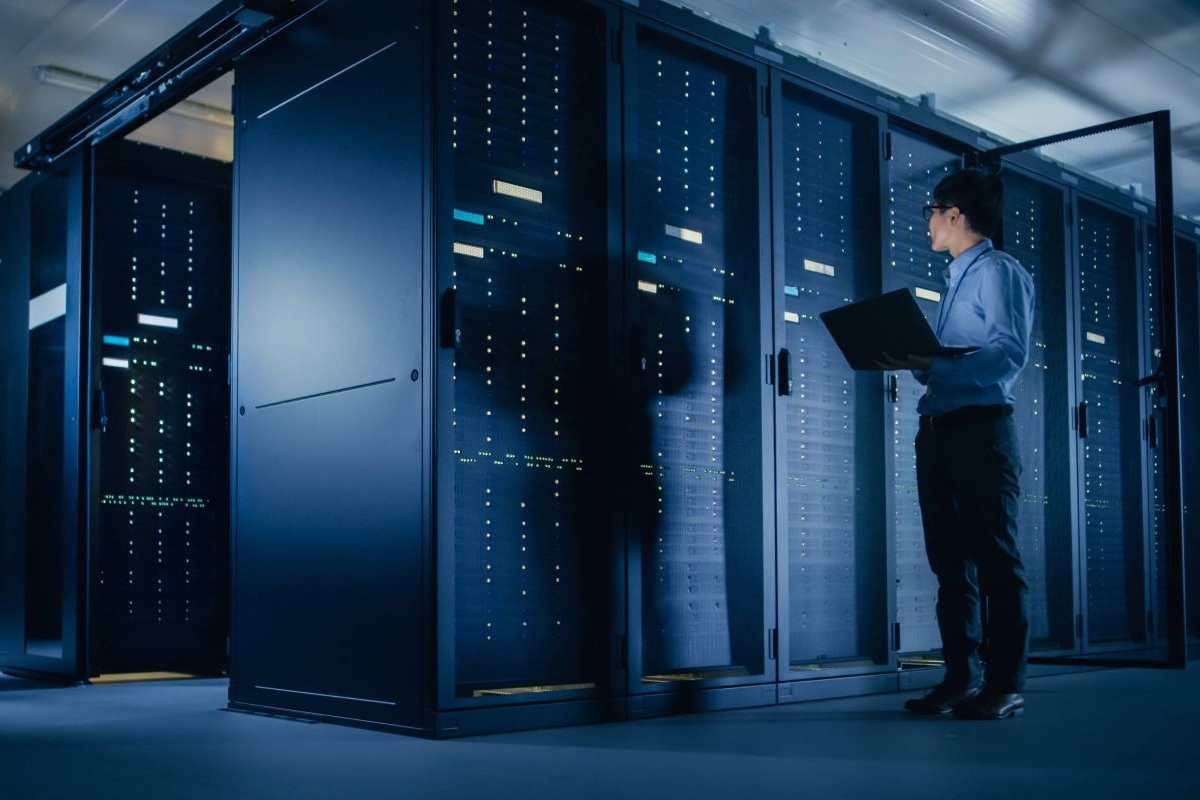Liquid Cooling Technologies Driving Data Centre Efficiency
Artificial Intelligence in Data Centre Operations
Cooling
Data
Data Centre Operations: Optimising Infrastructure for Performance and Reliability
Data Centres
Liquid Cooling Technologies Driving Data Centre Efficiency
Compu Dynamics launches AI and HPC Services unit
Compu Dynamics has announced the launch of its full lifecycle AI and High-Performance Computing (HPC) Services unit, showcasing the company’s end to end capabilities.
The expanded portfolio encompasses the entire spectrum of data centre needs, from initial design and procurement to construction, operation and ongoing maintenance, with a particular emphasis on cutting-edge liquid cooling technologies for AI and HPC environments.
Compu Dynamics’ new AI and HPC service offerings build on the company’s expertise in white space deployment, including advanced liquid cooling and post-installation services. As a vendor-neutral solutions provider, the company is uniquely positioned to support equipment from virtually every manufacturer with no geographical limitations, ensuring clients receive unbiased recommendations and optimal solutions tailored to their specific requirements.
"Our advanced AI and HPC service offerings represent a significant evolution in data centre services," says Steve Altizer, President and CEO of Compu Dynamics. “We have created this team to respond to the accelerating demand for highly-qualified technical support for high-density AI data centre infrastructure. By working with a variety of OEM partners and offering true end-to-end solutions, we are empowering our clients to focus on their core business while we handle the complexities of their modern critical infrastructure."
The company’s holistic solutions portfolio addresses the growing need for specialised support in high-density computing environments. Compu Dynamics’ innovative liquid cooling solutions are said to offer superior efficiency and reduced energy consumption, making them essential for future-ready data centres. Key highlights of these service offerings include:
· Equipment evaluation, design consultation and procurement.
· Power distribution and liquid cooling system installation, startup, commissioning and quality assurance/quality control.
· Flexible maintenance service options designed for seamless, worry-free support including comprehensive fluid management, coolant sampling and contamination and corrosion prevention.
· Onsite staffing for day-to-day technical operations.
· Dedicated customer success manager.
· 24x7 emergency response team for technical issues and repair services.
"As AI and HPC workloads drive unprecedented demand on data centre infrastructure, our liquid cooling expertise has become increasingly crucial,” says Scott Hegquist, Director of AI/HPC Services at Compu Dynamics. “We're committed to helping our clients navigate these challenges, providing cutting-edge solutions that optimise performance, efficiency and sustainability."
Carly Weller - 11 April 2025
Cooling
Data Centres
Liquid Cooling Technologies Driving Data Centre Efficiency
News
Castrol and Schneider Electric launch liquid cooling lab in Shanghai
Castrol and Schneider Electric have opened a new liquid cooling technology co-laboratory in Shanghai under a strategic partnership agreement. This collaboration aims to offer customers new innovations in data centre cooling technology.
The co-laboratory will support the development of benchmark liquid cooling projects for data centres in the future. It will also serve as a jointly branded customer demonstration centre, showcasing significant breakthroughs in liquid cooling technology to the data centre industry.
Castrol and Schneider Electric will work together to carry out in-depth product development and projects that can address the practical technical challenges faced by customers – such as compatibility between the cooling liquid and devices, and improving heat dissipation, among other issues. Through joint research and development, technology sharing and other approaches, both companies will aim to expand the adoption of liquid cooling technology across various scenarios.
Castrol's high-performance cooling liquids will be integrated with Schneider Electric's data centre solutions, including infrastructure such as the Cooling Distribution Unit (CDU), power supplies, server rack and intelligent power distribution equipment. In the future, both companies will collaborate to achieve further in-depth integration by conducting compatibility tests of data centre liquid cooling fluids and infrastructure. This will help ensure the stability and safety of the combined products of Castrol and Schneider Electric and provide one-stop liquid cooling solutions for more customers.
At the opening of the co-laboratory, Peter Huang, Vice President, Thermal Management at Castrol, said, "In the era of AI, the construction of liquid cooling infrastructure in data centres is developing rapidly. Through Castrol’s strategic partnership with Schneider Electric, we will jointly provide end-to-end solutions for the construction, operation and maintenance of data centres, ranging from the hardware in server rooms to liquid cooling fluids."
Castrol and Schneider Electric are committed to providing higher-quality data centre liquid cooling services and promoting safe and energy-efficient development of data centres that are fit for the future.
Carly Weller - 8 April 2025
Cooling
Data Centres
Liquid Cooling Technologies Driving Data Centre Efficiency
News
Carrier introduces QuantumLeap for data centres
Carrier Global Corporation, a provider of intelligent climate and energy products, has unveiled Carrier QuantumLeap, a comprehensive suite of purpose-built innovations designed to support the rapidly expanding data centre industry.
With the global data centre cooling market projected to reach $20 billion (£15.8bn) by 2029, Carrier is positioning itself for significant growth by expanding its portfolio of advanced, energy-efficient cooling products, creating customisable aftermarket programmes, scaling manufacturing and engineering capacity, and collaborating with global technology experts.
"Carrier QuantumLeap represents the next evolution in data centre thermal management, integrating our most advanced cooling, controls and service solutions to deliver a highly efficient, state-of-the art cooling system tailored to each customer’s needs,” says Christian Senu, Executive Director, Data Centers, Carrier. "With AI-driven growth, our innovative solutions - such as the integration of direct-to-chip liquid cooling with traditional HVAC cooling systems optimised through intelligent controls platforms - allow data centres to maximise efficiency and reliability. AI will continue to strain power grids, increasing demand for intelligent, integrated thermal management solutions that Carrier is uniquely positioned to deliver.”
Carrier QuantumLeap provides a fully integrated suite of products to manage the entire thermal lifecycle of data centres. From chip to chiller, Carrier can deliver end-to-end thermal management through intelligent cooling, digital controls, and predictive monitoring and service, ensuring real-time optimisation, adaptability and efficiency across data centre operations. This scalable system-wide approach maximises performance and energy efficiency in even the most demanding environments.
Included in the suite of products are the following:
Chillers and air handling technologies: Carrier provides a range of next-generation chiller products, including screw and centrifugal compression systems with magnetic bearing technology, and custom air handling systems. Designed for seamless integration into the broader thermal ecosystem, these high-efficiency solutions are 30% more efficient than prior generations of products. They feature integrated free cooling, elevated chilled water temperatures and optimised energy use, ensuring consistent performance to meet the demands of AI-driven computing.
Liquid cooling: Carrier’s latest innovation, the Cooling Distribution Unit (CDU), enables seamless integration into direct-to-chip (DTC) liquid cooling systems for high-density environments.
Differentiated controls solutions: Carrier’s advanced Automated Logic building management system and digital platform serve as the intelligence hub of this interconnected ecosystem, empowering operators with unparalleled transparency and precision control.
Data centre infrastructure management: Today, Carrier Nlyte's data centre management, optimisation, and compliance reporting solutions are deployed in more than 300 data centres. These facilities, spanning enterprise, colocation and edge environments, are efficiently managing and optimising over one million racks and 10 million data points using Nlyte's innovative technology and delivering energy savings, cost reductions and improved resiliency.
Predictive maintenance and service: Carrier’s global service network, supported by a network of skilled technicians and factory-authorised spare parts, provides operational reliability and proactive issue resolution. In addition, Carrier’s digital platform, Abound, provides real-time insights, remote diagnostics and predictive maintenance capabilities – enabling data-driven, outcome-based results that minimise downtime, maximise uptime and enhance performance across the data centre ecosystem.
Carrier’s acceleration in the data centre market is driven by growth investments in emerging cooling technologies, expanded capabilities and strategic partnerships:
Investment in Strategic Thermal Labs (STL): In 2024, Carrier Ventures invested in STL, a provider of liquid cooling technologies. Strategic Thermal Labs, LLC (STL) is an Austin-area heat transfer research and development company with industry-renowned expertise in data centre liquid cooling. Building on its strong reputation, STL is a trusted partner to some of the largest server manufacturers and data centre operators, providing valuable insights into both current and next-generation data centre cooling technologies.
Expanded manufacturing and engineering capacity: Carrier expects to double its commercial HVAC manufacturing capacity by the end of the year and optimise its engineering lab capacity to develop and scale next-generation cooling solutions to meet surging demand while driving continued innovation.
For more from Carrier, click here.
Simon Rowley - 21 February 2025
Cooling
Data Centres
Liquid Cooling Technologies Driving Data Centre Efficiency
News
Vertiv to launch Liquid Cooling Services portfolio
Vertiv, a global provider of critical digital infrastructure and continuity products, has announced the launch of Vertiv Liquid Cooling Services. The company states that this offering provides customers with the tools to enhance system availability, improve efficiency, and navigate the evolving challenges of advanced liquid cooling systems with confidence.
Vertiv has been delivering these services for more than a year to regional early adopters, refining best practices and gaining valuable insights that have now enabled the expansion of its liquid cooling service capabilities on a global scale. This experience brings a mature and proven approach, Vertiv tells us, providing data centre operators worldwide with expert support based on real-world application and success.
AI workloads continue to reshape the data centre landscape, driving a significant increase in data centre rack densities, with 30 kW racks now becoming the standard and some reaching up to 120 kW or higher. Operators are facing increased heat loads and higher power densities, and thus the need for liquid cooling solutions to maintain operational continuity is in high demand.
“The increasing reliance on liquid-cooled AI servers necessitates a comprehensive approach to lifecycle management,” says Sean Graham, Research Director of Cloud and Data Centre at IDC. “Given the complexities inherent in these cooling ecosystems, a robust support programme is not merely advisable, but a best practice to ensure both system availability and long-term operational viability.”
Vertiv's Liquid Cooling Services offering is focused on providing seamless integration of liquid cooling systems with IT equipment and adjacent infrastructure. It includes expert installation and commissioning, ongoing maintenance with special attention to fluid management, cleanliness, and preventing air from entering the system - which is key for system reliability
Vertiv believes that traditional maintenance practices aren't enough for the complexities of liquid cooling systems supporting critical AI applications. This offering leverages the company's industry experience and provides best-practices delivery of preventive and condition-based maintenance to provide reliable and efficient system performance and to maximise availability.
Vertiv Liquid Cooling Services includes a full range of solutions designed to support AI-driven and high-performance computing environments, providing seamless integration, long-term reliability, and operational continuity. Vertiv’s certified technicians and field engineers provide expert support at every stage, confirming that heat rejection systems and cooling loop fluid systems function optimally:
• Startup & Commissioning Services – Proactively identify and address potential issues that could result from improper installation, preventing delays and enabling a smooth and efficient system launch while verifying quality of all of the connected equipment.• Spare Parts Availability – Quick access to replacement components, supporting faster repairs when needed, and reducing potential downtime.• End-to-End Lifecycle Support – Digital, proactive system maintenance is at the core of this offering, allowing long-term reliability and optimised cooling performance. Documentation of all processes supporting the secondary fluid network provides a health history for the equipment to inform ongoing support.• Comprehensive Fluid Management Services – Maintaining optimal coolant quality is essential for reliable system performance. Vertiv’s services include coolant sampling, laboratory testing, contamination prevention, and environmentally responsible disposal to maximise system longevity and efficiency while enhancing system resilience of the secondary fluid network and technology cooling system.• Emergency and preventive support: Emergency response teams provide rapid, on-site and remote support to diagnose and resolve issues, minimising downtime and restoring operations quickly.
“High-performance computing (HPC) and AI are critical to business innovation and competitive advantage, making reliability and efficiency in supporting critical digital infrastructure more important than ever," says Ryan Jarvis, Vice President Global Services Business at Vertiv. "As organisations continue to invest in AI-driven systems, they need robust liquid cooling solutions to protect their investment and to enable long-term performance."
Vertiv Liquid Cooling Services leverages the Vertiv Global Services network, which provides project services, product support, testing and training for Vertiv’s portfolio of products. Backed by over 240 service centres, more than 3,500 field engineers, and 190-plus technical response specialists, Vertiv provides expert support across multiple regions.
The new Liquid Cooling Services offering is now globally available.
For more from Vertiv, click here.
Simon Rowley - 11 February 2025
Data Centres
Liquid Cooling Technologies Driving Data Centre Efficiency
News
Sustainable Infrastructure: Building Resilient, Low-Carbon Projects
Verne expands Helsinki data centre campus
Verne, a provider of sustainably powered HPC data centres across the Nordics, has acquired the land at its existing Helsinki data centre campus, securing room for future expansion. The company says that the purchase marks another milestone in its ambitious growth strategy for the Nordics, following the recent announcement of its new facility to be built in Mäntsälä, Finland.
Verne plans to develop the site further, leveraging its 70MW capacity to meet the increasing demand for sustainable, high-performance compute infrastructure. The land was acquired from Onvest, a family-owned company with a long history in the region.
The existing site in Helsinki currently serves a number of high-profile multinational customers. Verne tells us that its strategic location provides excellent connectivity to power and fibre networks, proximity to Helsinki Airport, and easy access to the city centre – making it ideal for organisations across industries looking for reliable, accessible, and well-connected facilities.
Designed with high-density compute in mind, the planned expansion will include two new buildings fully equipped to meet the technical requirements of AI, HPC, and other intensive workloads.Verne remains committed to sustainability, with the Helsinki campus running on 100% renewable energy. Waste heat generated by the data centre is repurposed through a direct connection to the local district heating network.
All new facilities will be built to support liquid cooling, enabling efficient management of the high heat levels generated by AI and other intensive compute workloads. This design makes the existing heat reuse infrastructure even more vital, facilitating the effective capture and repurposing of waste heat.Additionally, Verne uses renewable diesel for its backup power generators in Finland, reducing greenhouse gas emissions from the generators by an average of 90%.
“The acquisition of this site reinforces Verne’s long-term commitment to Finland and provides an even stronger foundation for our continued growth in the region,” says Dominic Ward, CEO of Verne. “We’ve seen a huge uplift in demand, and having successfully operated from this location for a number of years, we are well-positioned to scale our capabilities and continue delivering industry-leading, sustainable data centre solutions to support the next generation of AI and high-performance computing.”
For more from Verne, click here.
Simon Rowley - 7 February 2025
Data Centre Build News & Insights
Data Centre Projects: Infrastructure Builds, Innovations & Updates
Data Centres
Liquid Cooling Technologies Driving Data Centre Efficiency
News
Sustainable Infrastructure: Building Resilient, Low-Carbon Projects
Yondr Group holds ground-breaking for Toronto data centre
Yondr Group, a global developer, owner and operator of hyperscale data centres, has held a ground-breaking ceremony to mark the start of work on site for its 27MW Toronto data centre.
The project, which Yondr is building on a 4.5-acre site, is the company’s first development in Canada. It forms part of Yondr’s global expansion, as the business continues to deliver reliable and resilient data centre capacity at speed and at scale, with projects currently completed or in progress in North America, Europe and Asia.
The ground-breaking in Toronto follows the completion of the company’s 48MW data centre project in Northern Virginia, and the first ready for service (RFS) milestone for the company’s 40MW Frankfurt data centre last November.
The ceremony was attended by Councillor Shelley Carroll of Don Valley North, who gave a speech highlighting the city’s thriving digital economy and emphasised Toronto’s vision of becoming a global hub for innovation and talent. The event also brought together key stakeholders all united in their vision of building a more connected and future-proofed Toronto.
Situated in a strategic location within Canada’s emerging data centre hub, the project comprises a three-storey, 27MW data centre, which is scheduled to achieve RFS by mid-2026. The project has been designed by Yondr to follow the Toronto Green Standard, the city’s sustainable design and performance requirements for new developments, and this aligns with the company’s environmental goals and target for achieving net zero for scope 1 and 2 carbon emissions by 2030.
The building will feature a closed loop cooling design, which means once the chilled water loop is filled, the facility will not need to consume water for cooling. Once completed, the project will have bike parking, electric vehicle charging points and will open up pedestrian walkways. The environmentally friendly landscaping plan will have native and pollinator plants, and the building’s glass will be bird-friendly, helping birds to see the building as a barrier and avoid collisions.
As part of its social impact initiatives, Yondr has partnered with the University of Toronto to fund a scholarship programme. ‘The Yondr Group Scholarship’ will be available to undergraduate students at the university entering courses in Computer Science, the Rotman Commerce business programme, Life Sciences, or Mathematical & Physical Sciences.
Successful applicants will receive $5,000 per year for five years, with the first awards being made to students starting their studies at the beginning of the 2025/26 academic year this coming autumn.
Kent Andersson, Program Controls Director for the Americas at Yondr Group, says, “Our Toronto data centre forms a key part of our strategy for North America, where there is an urgent need to increase capacity to support the digital economy. This project will play a key role in providing the infrastructure needed to support cutting-edge cloud computing and connectivity, and enable the development of AI and future technologies in Canada and beyond.
“We would like to thank the Canadian authorities, including the City of Toronto and our strategic partners, for supporting a positive approach to bringing this project from concept to site, and I look forward to seeing the data centre take shape on site over the coming months.”
For more from Yondr Group, click here.
Simon Rowley - 31 January 2025
Cooling
Data Centres
Infrastructure Management for Modern Data Centres
Liquid Cooling Technologies Driving Data Centre Efficiency
News
Sustainable Infrastructure: Building Resilient, Low-Carbon Projects
DeepCoolAI and Sanmina partner to scale AI infrastructure
DeepCoolAI, an expert in AI infrastructure (including liquid cooling and high density solutions), and Sanmina Corporation, a specialist in advanced manufacturing, have announced a strategic partnership that seeks to revolutionise AI-driven data centres.
Together, the companies are striving to set new standards in efficiency, flexibility and sustainability, catering to the ever-growing demands of AI-driven, high-performance computing environments.
“Our partnership with Sanmina amplifies DeepCoolAI’s mission to pioneer cooling innovations for AI-driven data centres,” says Kris Holla, Founder and CEO of DeepCoolAI. “By integrating our technology, innovation and AI customised solutions with Sanmina’s global footprint and manufacturing expertise, we empower customers to achieve greater efficiency, unparalleled performance and high availability at scale. Together, we are building a future filled with unparalleled possibilities."
Hari Pillai, President, Technology Components Group at Sanmina, comments, “Leveraging Sanmina’s state-of-the-art manufacturing facilities around the world, as well as the depth and experience of our design and manufacturing teams that have successfully brought multiple Open Compute Project (OCP) rack and power solutions to market, this partnership ensures rapid deployment of reliable, high-quality AI solutions tailored to each customer's unique needs.
“From liquid-to-liquid and liquid-to-air Coolant Distribution Units (CDUs) to prefabricated modular high density solutions, DeepCoolAI and Sanmina are equipping data centres with the tools to exceed operational goals. The portfolio also emphasises seamless rack level integration with liquid cooling and high density power, enabling customers to deploy cooling systems with high availability and flexibility at scale.”
“Our strategic alliance with DeepCoolAI brings an unprecedented combination of innovation and scalability to the data centre market. Together, we’re delivering future-proof AI infrastructure solutions that optimise efficiency and sustainability for the next generation of AI driven workloads. We are committed to the fast-growing data centre market with unprecedented scalability and manufacturing capacity to help our customers to turn on data centres faster.”
Innovation to set a new benchmark
AI-powered precision: Innovative liquid cooling and high density technology for sustainability and rapid scalability.
High availability and sustainability at the core: Solutions are designed to meet high availability, stringent environmental standards, aligning with global carbon neutrality goals.
Global reach, local support: Sanmina’s robust supply chain ensures consistent delivery of solutions worldwide, backed by regional expertise and customer support.
Simon Rowley - 21 January 2025
Cooling
Data Centres
Liquid Cooling Technologies Driving Data Centre Efficiency
News
Telehouse launches new liquid cooling lab
Addressing the thermal challenges of today’s high-performance computing and AI workloads, Telehouse International Corporation of Europe, a global data centre service provider, has announced the launch of its liquid cooling lab following the development of strategic partnerships with four of the world’s most advanced liquid cooling technology providers.
From early 2025 onwards, the four companies – Accelsius, EkkoSense, JetCool, and Legrand – will showcase their advanced cooling technologies at the new, state-of-the-art liquid cooling lab at Telehouse South, the latest addition to Telehouse’s London Docklands campus. This project will enable Telehouse customers to explore cutting-edge liquid cooling innovations and find an option that works best for their needs.
Accelsius is bringing its NeuCool platform to Telehouse’s London data centre, introducing a two-phase, direct-to-chip cooling technology that uses a waterless, non-conductive refrigerant for heat removal. Removing an average heat flux of 250W/cm² and hot spot heat fluxes above 500W/cm², NeuCool offers substantial performance headroom for AI and high-performance computing.
The deployment will include the Accelsius Thermal Simulation Rack, a patent-pending system with Load Simulation Sleds that replicate high-power servers, enabling users to control, monitor, and measure the impressive cooling and computational performance delivered by NeuCool technology. Telehouse clients will also have access to a live performance portal for real-time data and seamless demonstrations of the system’s capabilities.
JetCool, a Flex company, will provide its SmartPlate System in the Liquid Cooling Lab - a self-contained liquid cooling product in compact 1U and 2U form factors. Requiring no piping, plumbing, or facility modifications, the SmartPlate System provides a hassle-free approach to efficient cooling. JetCool’s patented microconvective liquid cooling technology handles the highest-power CPUs, GPUs, and AI accelerators, cooling Superchips over 3,500W and outperforming microchannel-based designs by up to 30%, as validated by third-party testing.
JetCool’s product suite extends beyond self-contained systems to integrated rack-level liquid cooling products. These incorporate JetCool’s in-rack SmartSense Coolant Distribution Unit (CDU), capable of cooling up to 300kW per rack or neighbouring racks, with scalability to row-based configurations exceeding 2MW. JetCool’s flexible technology enables Telehouse tenants to choose products ranging from liquid-assisted air cooling to full-scale liquid cooling, meeting the demands of today’s high-performance computing and AI workloads.
Legrand will install its USystems ColdLogikCL20 Rear Door Heat Exchanger (RDHx), supporting over 90kW capacity per cabinet. Its ColdLogik RDHx negates heat at source and removes the need for air-mixing or containment. Ambient air is drawn into the rack via the IT equipment fans, and the hot exhaust air is expelled from the equipment and pulled over the heat exchanger assisted by EC fans mounted in the RDHx chassis. The exhaust air transfers heat into the coolant within the heat exchanger, and the newly chilled air is expelled into the room at, or just below, the predetermined room ambient temperature designed around sensible cooling.
Both processes are managed by the ColdLogik adaptive intelligence, using air-assisted liquid-cooling to control the whole room temperature automatically at its most efficient point.
EkkoSense, a provider of AI-powered data centre optimisation software, will deploy to Telehouse's lab its innovative EkkoSim ‘what-if?’ scenario simulations; low-cost air-side and liquid-side monitoring sensors; web-based EkkoSoft Critical 3D visualisations with analytics and AI-powered advisory; and anomaly detection tools. Because the latest AI compute hardware and hybrid cooling infrastructure introduce new levels of engineering complexity, EkkoSense deploys the power of AI to capture, visualise, and analyse data centre performance.
Telehouse has already deployed EkkoSense’s EkkoSoft Critical platform across its London Docklands campus, optimising data centre cooling performance. A key benefit for the Telehouse operations team has been how the EkkoSense AI-powered platform has not only improved visibility into cooling and capacity performance, but also helped to reduce the administrative burden for already busy Telehouse team members.
For more from Telehouse, click here.
Simon Rowley - 15 January 2025
Cooling
Data Centres
Liquid Cooling Technologies Driving Data Centre Efficiency
News
The data centre liquid cooling market outlook
According to analysis by Persistence Market Research, the data centre liquid cooling market is projected to grow from $4.1 billion in 2024 to $19.4 billion by 2031, at a robust CAGR of 24.6%.
This growth, the research firm says, is fuelled by increasing data centre density, the need for energy-efficient cooling systems, and rising adoption of High-Performance Computing (HPC). Liquid cooling systems offer superior energy efficiency, cutting energy use by up to 40% compared to air cooling. Major cloud providers and hyperscale data centres are driving demand for innovative solutions like cold plate cooling and immersion cooling, which address the challenges of high thermal loads and sustainability. North America leads the market with a significant share, supported by booming cloud computing and favorable regulatory policies.
The growing need for efficient cooling solutions
As data centres continue to expand in scale and capacity, the demand for efficient cooling mechanisms has grown exponentially. Traditional air-cooling systems, though widely used, are struggling to meet the energy efficiency and thermal management needs of modern high-performance computing (HPC) systems. Liquid cooling is emerging as a revolutionary solution to address these challenges.
Liquid cooling systems utilise water or specialised cooling fluids to absorb and dissipate heat generated by servers and IT equipment. Unlike air cooling, liquid cooling has a significantly higher thermal transfer efficiency, making it ideal for densely packed data centres. Key components of these systems include cold plates, heat exchangers, and pumps that work in synergy to maintain optimal operating temperatures.
Growth projections and industry trends
The global data centre liquid cooling market is witnessing robust growth, with projections estimating a CAGR of over 20% between 2024 and 2032. This surge is driven by the increasing deployment of advanced IT infrastructure and rising energy costs. Furthermore, environmental concerns are pushing data centre operators to adopt greener, more energy-efficient cooling solutions, further boosting the adoption of liquid cooling.
Liquid cooling offers several advantages over conventional air-cooling methods:
- Enhanced energy efficiency: With the ability to directly cool components, liquid cooling reduces overall energy consumption.
- Higher cooling capacity: It supports high-density server configurations, enabling better utilisation of physical space.
- Reduced noise and maintenance: Liquid cooling systems operate quietly and require less frequent maintenance compared to air-cooling setups.
Applications across industries
Liquid cooling is not limited to a single sector; it is being rapidly adopted across industries such as cloud computing, artificial intelligence, and blockchain technology. These sectors require immense computational power, making efficient thermal management critical to their operations.
Key challenges in liquid cooling implementation
Despite its advantages, implementing liquid cooling comes with its own set of challenges:
- Initial investment costs: The upfront cost of installing liquid cooling systems can be prohibitive for smaller enterprises.
- Complexity in design and maintenance: Designing an efficient liquid cooling system requires expertise, and regular maintenance can be complex.
- Risk of leakage: While rare, leakage of coolant fluids can pose a risk to critical IT equipment.
Innovations driving adoption
Innovations in liquid cooling technology are making these systems more accessible and reliable. For instance, immersion cooling - where servers are submerged in non-conductive cooling fluids - is gaining traction for its simplicity and effectiveness. Similarly, modular cooling systems are enabling scalability and easier integration into existing data centre architectures.
Regional insights: where growth is happening
The data centre liquid cooling market is experiencing significant growth across various regions:
- North America: Leading the market due to its extensive data centre infrastructure and focus on green technologies.
- Europe: Accelerating adoption driven by stringent energy efficiency regulations.
- Asia-Pacific: Witnessing rapid growth due to the booming IT sector and increasing investments in data centre facilities.
Future outlook: sustainability and beyond
The future of data centre cooling lies in sustainable technologies. Liquid cooling systems are poised to play a pivotal role in achieving carbon-neutral data centres. Innovations like water-free cooling systems and closed-loop solutions are expected to further enhance the eco-friendliness of these systems.
The path ahead for liquid cooling
Data centre liquid cooling represents the next frontier in thermal management solutions. As technological advancements continue to reshape the IT landscape, liquid cooling systems will be essential in meeting the performance and sustainability demands of future data centres. Their adoption not only ensures energy efficiency but also aligns with global efforts toward environmental conservation.
Simon Rowley - 6 January 2025
Cooling
Data Centres
Liquid Cooling Technologies Driving Data Centre Efficiency
News
Castrol launches new direct-to-chip cooling fluid
Castrol has announced the launch of Castrol ON Direct Liquid Cooling PG 25, a new propylene glycol-based cooling fluid specifically designed for direct-to-chip cooling applications in high-performance data centres.
The ready-to-use solution helps meet the complex thermal management needs of today's high-performance computing, while offering protection against corrosion and bacterial growth.
Castrol ON PG 25 has been developed to meet the rapidly growing adoption of direct-to-chip cooling technology in data centres, driven by the demand for higher computing densities, particularly for applications like AI, machine learning, and high-performance computing. The global data centre cooling market is expected to reach $16.8 billion by 2028, with direct-to-chip cooling becoming widely adopted.
Traditional air cooling, which currently dominates data centre cooling, often cannot efficiently manage the heat generated by densely packed, high-power servers.
To address these escalating cooling demands, the industry is turning to more efficient solutions like direct-to-chip cooling which delivers liquid coolant directly to heat-generating components, enabling faster heat transfer and reducing the reliance on energy-intensive air conditioning systems.
This approach helps maintain the optimal operating temperatures crucial for system reliability and performance.
"As data centres continue to push the boundaries of computing power, direct-to-chip cooling offers an opportunity for data centres to manage the increasing thermal demands of next-generation processors," says Peter Huang, Global Vice President of Thermal Management, Castrol. "Through the launch of PG 25, we are combining Castrol's expertise in thermal management with our global capabilities to help customers meet their cooling challenges with efficiency."
Castrol’s new PG 25 fluid offers several key advantages for data centre operators:• Non-toxic propylene glycol formulation for enhanced safety in sensitive computing environments• Extended protection against metal corrosion and bacterial growth• Comprehensive compatibility with common cooling system materials• Ready-to-use 25% concentration requiring no dilution• Global availability backed by Castrol's technical support network
Castrol ON Direct Liquid Cooling PG 25 is supported by the company's comprehensive operational support and monitoring solutions, enabling data centre operators to optimise the performance of their cooling systems throughout their lifecycle.
"Through research and collaboration with our customers and technology partners, we've developed a truly end-to-end solution that supports data centres to rapidly implement and benefit from direct-to-chip cooling technologies while anticipating the future needs of the industry," adds Sung A Kim, Global Head of Technology for Data Centre Liquid Solutions, Castrol. "Further, our global network will enable us to provide comprehensive support all the way from initial testing to deployment, supporting our customers to confidently implement direct-to-chip cooling solutions across their facilities."
With the addition of Castrol ON Direct Liquid Cooling PG 25 to Castrol’s existing range of immersion cooling fluids and associated services, Castrol can be a one-stop partner for meeting the liquid cooling solutions of today and tomorrow.
The product is now available through Castrol's distribution network in selected markets.
For more from Castrol, click here.
Simon Rowley - 16 December 2024

Head office & Accounts:
Suite 14, 6-8 Revenge Road, Lordswood
Kent ME5 8UD
T: +44 (0)1634 673163
F: +44 (0)1634 673173









